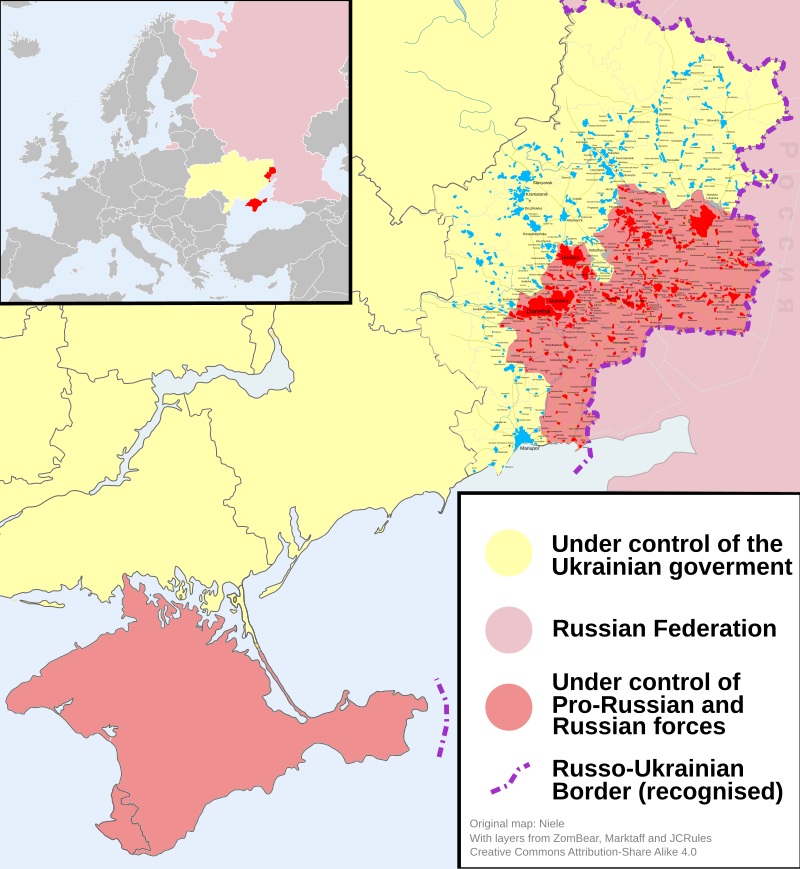Ukraine, a former Soviet republic, has been an independent country since the Soviet Union’s collapse in 1991. However, for centuries Ukraine was an integral part of the Russian Empire, and then of the Soviet Union, with positive ties that include language, religion, economics, culture, and geopolitics.
There is a fair amount of anti-Russian antipathy among Ukrainians as well. In the 1930s Stalin perpetrated the Holodomor, a Soviet campaign of forced starvation that killed millions of Ukrainians; and in 1986 the Chernobyl nuclear disaster in Ukraine killed untold numbers because of an inadequate Soviet response. There is therefore both pro-Russian and pro-Ukrainian support among people in Ukraine – and for various reasons.
Current Russian expansionism is obvious in many parts of the world, including in Syria’s internationalized civil war and in Russian interference in UK and US internal politics. However, nowhere has expansionism been more overt than in the Russo-Ukrainian War that started in February 2014 and continues into 2020 in the Crimean peninsula, the Donbass region of eastern Ukraine, and in other locations.
Russian Military Intervention in Ukraine since 2014
The map of 2014 Russo-Ukrainian War illustrates several key points: 1) Russia completely occupies the Crimean Peninsula in the south; 2) Russian forces occupy a significant part of the east Donbass region; and 3) Russian forces fight for control in northern and northwestern Donbass.
Russian incursion into Crimea: At the end of 2013, Ukraine’s pro-Western government began to make moves to join the European Union, threatening Russia’s economic relationship with Ukraine. In February 2014, troops that were identified as Russian began occupying crucial infrastructure in Crimea in armed opposition to Ukraine’s Westernizing government. In addition to this military presence, Russia provided support to Ukrainian separatist groups who aligned with Russia, creating a violent civil conflict that persists today, six years on [1].
Russian Incursion into the Donbass Region: In the eastern region of Donbass, the conflict between Russian military troops and Russian-allied separatists against the Ukrainian government escalated into open warfare. The UN reports that 13,000 people have been killed, a quarter of them civilians, and as many as 30,000 people have been wounded and another 1.5 million displaced since the war began in April 2014[2].
Maritime Control: In November 2018, Russia captured three Ukrainian ships that were passing through the Kerch Strait from the Black Sea to southeast Ukraine. This action violated a 2003 treaty between the two countries that had demarked the Strait as shared water [3].
This act of military aggression nullified the 2003 treaty. By controlling key maritime access to Crimea, Russia accomplished two goals. First, this limited Ukraine’s ability to provide support for its military forces, giving Russian-backed rebels an advantage. Second, Russia demonstrated its control over Ukraine by disregarding an international treaty that the two countries had signed, a symbolic declaration of Russia’s power over Ukraine. Russia’s actions in Ukraine expand regional power and influence. Putin is growing his own personal power as well. On March 10, 2020, he pushed through legislation allowing him to serve as president until 2036, for a total of 32 years; that legislation has just been delayed due to the pandemic but is likely to occur [4].
The International Response: Ukraine has sent two declarations to the International Criminal Court, and a preliminary investigation into the events in Crimea and the Donbass region are under way. The Minsk agreements, signed by Russia and Ukraine in 2014 and revised in 2015, have failed to deliver a lasting peace, and a monitoring mission of the Organization for Security and Co-operation in Europe (OSCE) continues to record human rights violations in eastern Ukraine [5].
Work Cited:
[1] https://www.militarytimes.com/news/your-military/2018/11/26/russias-conflict-with-ukraine-an-explainer/
[2]https://www.cfr.org/interactive/global-conflict-tracker/conflict/conflict-ukraine
[3]https://www.theguardian.com/world/2018/nov/27/kerch-strait-confrontation-what-happened-ukrainian-russia-crimea
[4]https://www.nytimes.com/2020/03/16/world/europe/russia-putin-president-for-life.html
[5]https://www.forbes.com/sites/paulroderickgregory/2016/11/20/international-criminal-court-russias-invasion-of-ukraine-is-a-crime-not-a-civil-war/#db50f47ddb25



